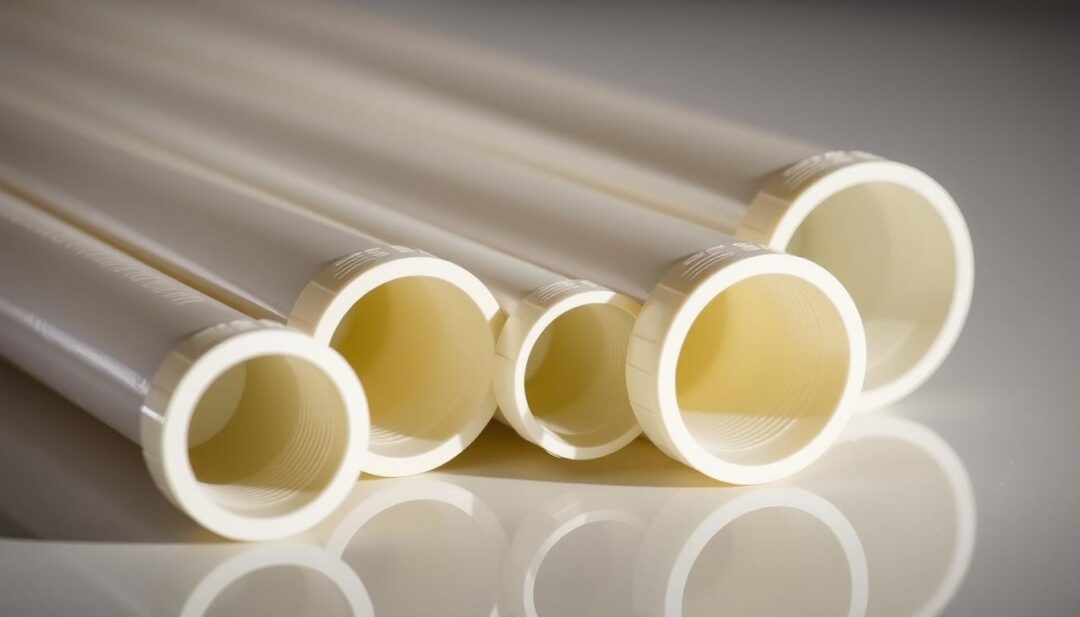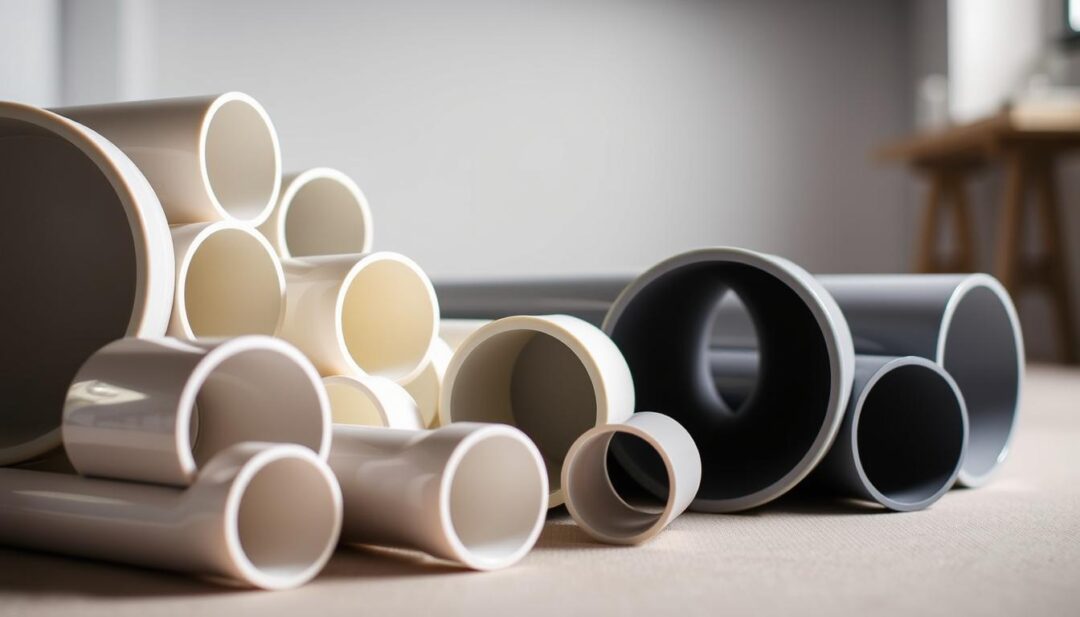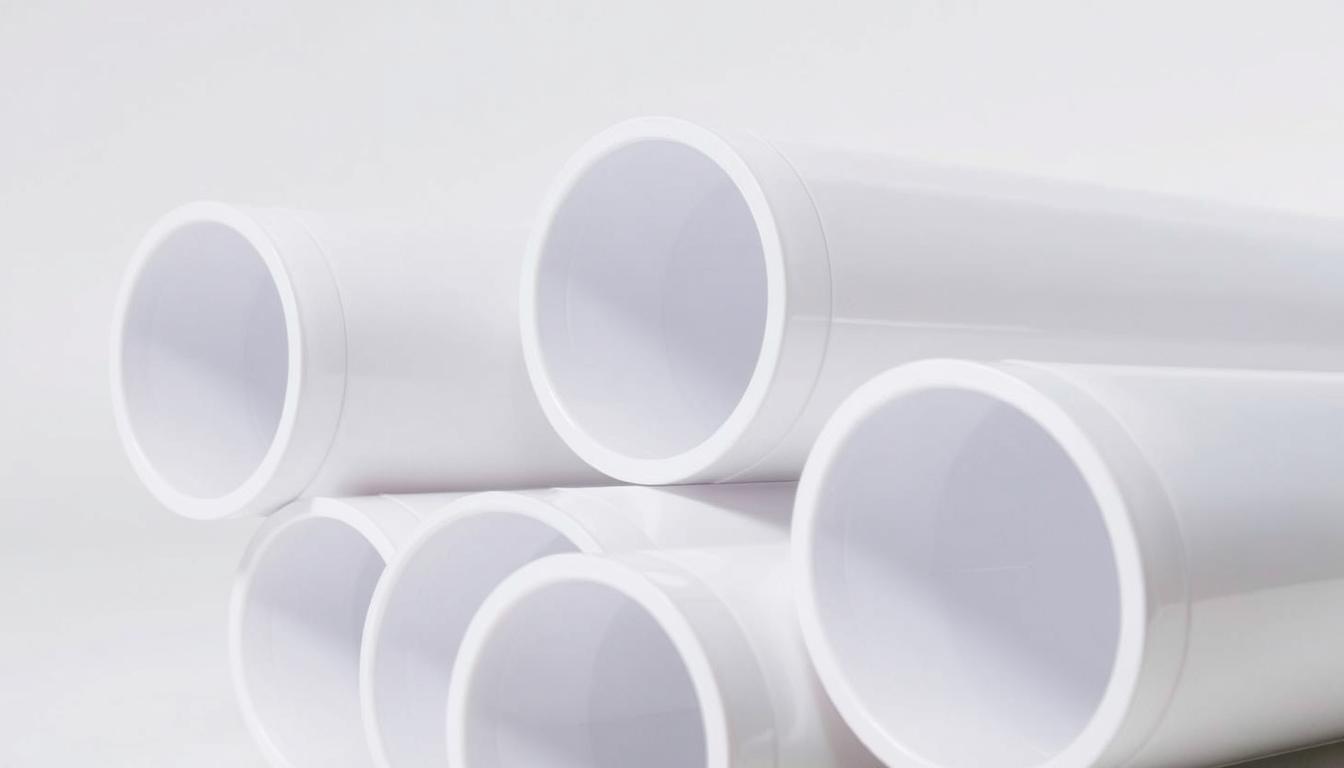What Size PVC Pipe for Gutter Drain?
Are you wondering if your home’s gutter system is equipped with the right PVC pipe size for effective water drainage?
Choosing the correct PVC pipe size is crucial for a well-functioning gutter system. While the standard diameter is 4 inches, factors such as the size of your roof, the intensity of rainfall in your area, and local building codes can influence the ideal size for your gutter drain.
Understanding the importance of proper sizing can help prevent issues like water damage and foundation problems. In this article, we’ll explore how to determine the appropriate PVC pipe size for your gutter drain system.
Key Takeaways
- The standard PVC pipe size for gutter drains is typically 4 inches.
- Roof size and rainfall intensity are key factors in determining the ideal PVC pipe size.
- Local building codes may specify requirements for gutter drain pipe sizes.
- Proper sizing is crucial for preventing water damage and foundation issues.
- Consulting with a professional can help ensure the right PVC pipe size for your gutter system.
Understanding Gutter Drainage Systems
Gutter drainage systems are crucial for protecting homes from water damage by directing rainwater away from the foundation. A properly functioning system prevents water accumulation, which can lead to structural issues and erosion around the house.
The Purpose of Gutter Drains
Gutter drains are designed to move rainwater from the roof to a safe discharge point, away from the house. This is achieved through a network of gutters, downspouts, and PVC pipes. The primary purpose is to prevent water from accumulating around the foundation, which can cause cracks, leaks, and other structural problems.
Components of a Complete Drainage System
A complete gutter drainage system includes several key components:
- Gutters: Collect rainwater from the roof.
- Downspouts: Direct water from gutters to the ground.
- Adapters: Connect downspouts to PVC pipes.
- PVC Pipes: Carry water away from the house to a safe discharge point.
Why Proper Sizing Matters
Proper sizing of PVC pipes is critical for the effective functioning of a gutter drainage system. Using the correct PVC pipe diameter for gutter drain ensures that water is efficiently channeled away from the house, preventing backups and potential damage. The best PVC pipe size for gutter drainage depends on factors such as rainfall intensity, roof size, and drainage distance.
| Factor | Impact on PVC Pipe Size |
|---|---|
| Rainfall Intensity | Higher intensity requires larger diameter pipes |
| Roof Size | Larger roofs require larger pipes to handle increased water volume |
| Drainage Distance | Longer distances may require larger pipes to prevent friction loss |
What Size PVC Pipe for Gutter Drain: Standard Options
The optimal PVC pipe size for gutter downspouts varies based on several factors, including roof size and rainfall intensity. Understanding the standard options available is crucial for making an informed decision.
2-Inch PVC Pipe Applications
A 2-inch PVC pipe is typically used for smaller residential gutter systems or for diverting water from downspouts to the main drainage line. It’s suitable for areas with moderate rainfall and smaller roof areas.
3-Inch PVC Pipe Applications
The 3-inch PVC pipe is a popular choice for many residential gutter drain systems. It offers a good balance between capacity and cost, making it suitable for average-sized roofs and moderate rainfall areas.
4-Inch PVC Pipe Applications
A 4-inch PVC pipe is considered standard for most gutter drain systems, especially for larger roofs or areas with heavy rainfall. It provides a higher capacity for water flow, reducing the risk of clogs and backups.
When to Consider Larger Diameters
In cases where the roof area is extensive or the region experiences heavy rainfall, considering larger diameter PVC pipes (beyond 4 inches) may be necessary. This ensures that the gutter drain system can handle the increased water volume efficiently.
Factors Affecting PVC Pipe Size Selection
To ensure efficient gutter drainage, it’s vital to choose the correct PVC pipe size based on several key factors. The size of the PVC pipe for your gutter downspout plays a crucial role in managing water runoff from your roof.
Rainfall Intensity in Your Area
The intensity of rainfall in your region significantly impacts the required PVC pipe size. Areas with heavy rainfall require larger pipes to handle the increased water volume.
Roof Size and Water Volume
The size of your roof directly affects the amount of water that needs to be drained. Larger roofs require larger PVC pipes to efficiently manage water runoff.
Slope and Drainage Distance
The slope of your land and the distance water needs to travel also influence PVC pipe size selection. Proper slope ensures that water flows freely, while longer drainage distances may require larger pipes.
Local Building Codes and Requirements
Local building codes and regulations often specify minimum requirements for gutter drainage systems, including PVC pipe sizes. Compliance with these codes is essential for safety and legal reasons.
By considering these factors, you can determine the correct PVC pipe size for your gutter downspout, ensuring efficient gutter drainage and protecting your property from water damage.
Calculating the Right PVC Pipe Size for Your Needs
Determining the correct PVC pipe size for your gutter downspout is crucial for effective water management. The size of the PVC pipe directly affects the efficiency of your gutter drainage system, influencing how well it can handle rainfall and prevent water damage.
Simple Formulas for Homeowners
Homeowners can use simple formulas to estimate the appropriate PVC pipe size based on their roof size and local rainfall intensity. A basic approach involves calculating the roof’s square footage and adjusting it according to the rainfall intensity in your area.
Professional Sizing Methods
For more accurate sizing, professional methods consider additional factors such as the slope of your roof, the distance water needs to travel, and local building codes. These methods often require specialized knowledge and may involve using detailed charts and tables.
Online Calculators and Resources
Online calculators can simplify the process of determining the ideal PVC pipe size. These tools typically ask for information about your roof size, local rainfall data, and other relevant factors, providing a recommended pipe size based on this input.
Step-by-Step Calculation Example
For instance, to calculate the required PVC pipe size, you might first determine your roof’s square footage. If your roof is 2,000 square feet and you live in an area with heavy rainfall, you may need a larger diameter pipe, such as 3 or 4 inches, to handle the increased water volume.

By using these methods and resources, homeowners can make informed decisions about their gutter drainage system, ensuring it is both effective and durable.
Regional Considerations Across the United States
Regional climate differences across the United States play a crucial role in determining the appropriate size of PVC pipes for gutter drains. Different regions face unique challenges, from heavy rainfall to snow and ice, or arid conditions, each requiring specific considerations for effective gutter drainage.
Sizing for Heavy Rainfall Regions
In areas prone to heavy rainfall, such as the southeastern United States, larger diameter PVC pipes are often necessary to handle the increased water volume. For instance, a 3-inch or 4-inch PVC pipe may be more suitable than the standard 2-inch pipe to prevent overflow and ensure proper drainage.
Considerations for Snow and Ice Regions
In colder climates where snow and ice are common, gutter drainage systems must be designed to handle the additional weight and potential for freezing. Using a Schedule 80 PVC pipe, which is thicker and more durable, can help prevent damage from freezing temperatures and ice blockages.
Arid Climate Solutions
In arid regions, the focus shifts from handling large volumes of water to preventing clogging from debris and ensuring the system’s longevity. Here, the choice of PVC pipe size may be influenced more by the roof size and the distance water needs to travel rather than the volume of rainfall.
Understanding these regional considerations is key to selecting the best PVC pipe size for gutter drainage. By taking into account the specific climate-related challenges of your area, you can ensure a more effective and durable gutter drainage system.
PVC Pipe Types and Schedules for Gutter Drains
The type and schedule of PVC pipe used for gutter drains can significantly impact the system’s overall performance. PVC pipes come in different schedules and types, each designed to meet specific requirements and conditions.
Schedule 40 vs. Schedule 80
PVC pipes are categorized into different schedules based on their wall thickness and pressure rating. Schedule 40 PVC pipes are commonly used for gutter drains due to their balance between cost and durability. They are suitable for most residential applications. Schedule 80 PVC pipes, on the other hand, have a thicker wall and are used in applications where higher pressure resistance is required.
| Characteristics | Schedule 40 | Schedule 80 |
|---|---|---|
| Wall Thickness | Thinner | Thicker |
| Pressure Rating | Lower | Higher |
| Cost | Generally Lower | Generally Higher |
DWV (Drain-Waste-Vent) PVC
DWV PVC pipes are specifically designed for drainage applications, including gutter drains. They are not pressure-rated like other PVC pipes but are optimized for gravity-flow applications. DWV PVC is a cost-effective option for gutter drainage systems.
Cellular Core vs. Solid Wall PVC
Cellular core PVC pipes feature a foamed core that reduces material costs and weight without significantly compromising strength. Solid wall PVC pipes, however, offer greater durability and resistance to physical damage. The choice between cellular core and solid wall PVC depends on the specific requirements of the gutter drainage system.

Color Considerations and UV Resistance
PVC pipes come in various colors, with some being more resistant to UV degradation than others. For underground applications, UV resistance is less of a concern, but for above-ground installations, selecting PVC pipes with UV stabilizers or painting them can extend their lifespan.
When selecting PVC pipes for gutter drains, it’s essential to consider the specific needs of your drainage system, including the expected water volume, local building codes, and environmental conditions. By choosing the right type and schedule of PVC pipe, you can ensure a durable and effective gutter drainage system.
Connecting Different Pipe Sizes and Components
Efficient gutter drainage relies heavily on the correct integration of various pipe sizes and associated components. A well-designed system ensures that water is effectively directed away from the foundation of your home, preventing potential damage.
Downspout to PVC Adapters
One of the critical connections in a gutter drainage system is between the downspout and the PVC pipe. Downspout to PVC adapters are designed to facilitate this connection, ensuring a secure and watertight seal. These adapters come in various sizes to accommodate different downspout dimensions and PVC pipe diameters.
Reducing Couplings and Fittings
As gutter drainage systems often require changes in pipe diameter, reducing couplings and fittings play a vital role. These components allow for smooth transitions between different pipe sizes, maintaining the system’s overall efficiency. They are available in various configurations, including reducers, elbows, and tees, to suit different installation needs.
Creating Effective Transitions
Creating effective transitions between different pipe sizes and components is crucial for the overall performance of the gutter drainage system. This involves not only using the right adapters and fittings but also ensuring that these connections are made in a way that minimizes turbulence and prevents backflow.
Watertight Sealing Methods
Achieving a watertight seal is essential when connecting different pipe sizes and components. This can be accomplished using various sealing methods, including solvent welding, rubber gaskets, and threaded connections. The choice of sealing method depends on the specific materials used for the pipes and fittings, as well as local building codes and regulations.
By carefully selecting and installing the appropriate adapters, couplings, and fittings, homeowners can ensure their gutter drainage system operates efficiently, protecting their home from water damage.
Installation Best Practices for Gutter Drain PVC Pipes
The key to a successful gutter drainage system lies in the proper installation of PVC pipes. Effective installation ensures that water is directed away from your home’s foundation, reducing the risk of damage and erosion.
Proper Slope Requirements
Achieving the correct slope is crucial for ensuring that water flows freely through the PVC pipes. A minimum slope of 1/4 inch per foot is generally recommended to prevent clogging and ensure efficient drainage. Proper sloping helps in reducing the risk of water accumulation, which can lead to various issues including pipe freezing and damage to the surrounding soil.
Underground Installation Considerations
When installing PVC pipes underground, it’s essential to consider the depth and surrounding soil conditions. Pipes should be buried at a depth that protects them from surface damage and freezing temperatures. Proper bedding with materials like gravel can help in stabilizing the pipes and improving drainage.
Freeze Protection Techniques
In colder climates, protecting PVC pipes from freezing is crucial. Techniques such as insulating the pipes or burying them below the frost line can help prevent freezing and bursting. Insulation materials like foam pipe insulation are effective in maintaining the temperature of the pipes.
Supporting and Securing Pipes
Proper support and securing of PVC pipes are vital to prevent sagging and damage. Pipe clamps and straps can be used to secure the pipes to the wall or foundation, ensuring they remain in place. A table outlining common pipe support spacing is provided below:
| Pipe Diameter | Maximum Support Spacing |
|---|---|
| 2 inches | 4 feet |
| 3 inches | 5 feet |
| 4 inches | 6 feet |
By following these best practices for installing gutter drain PVC pipes, homeowners can ensure a reliable and efficient drainage system that protects their property from water damage.
Cost Considerations and Budget Planning
Selecting the right PVC pipe size for your gutter downspout involves balancing cost with performance. The ideal PVC pipe diameter for your gutter downspout depends on several factors, including rainfall intensity and roof size.
Price Comparison of Different PVC Sizes
The cost of PVC pipes varies significantly by size. Here’s a comparison:
| Pipe Size (Inches) | Cost per Foot | Typical Application |
|---|---|---|
| 2 | $0.50 – $1.00 | Small roofs, low rainfall areas |
| 3 | $1.00 – $2.50 | Medium roofs, moderate rainfall |
| 4 | $2.50 – $4.00 | Large roofs, heavy rainfall areas |
Long-term Value vs. Initial Investment
While larger PVC pipes are more expensive upfront, they offer better performance and durability, potentially saving money in the long run through reduced maintenance and fewer replacements.
DIY vs. Professional Installation Costs
Homeowners must decide between DIY installation and hiring a professional. While DIY can save on labor costs, professional installation ensures proper sizing and fitting, potentially avoiding costly future repairs.
According to a study, “Proper installation of gutter drainage systems can reduce the risk of water damage by up to 70%.” –
Conclusion
Selecting the correct PVC pipe size is crucial for a functional gutter drainage system. As discussed, factors such as rainfall intensity, roof size, and local building codes play a significant role in determining the ideal pipe size.
By understanding these factors and using the right PVC pipe size, homeowners can prevent water damage, erosion, and other issues associated with poor gutter drainage. Whether you’re using a 2-inch, 3-inch, or 4-inch PVC pipe, ensuring it’s properly sized for your gutter system is key to its effectiveness.
For a successful installation, consider consulting local professionals or using online resources to determine the best PVC pipe size for your specific needs. Proper sizing, combined with correct installation practices, will result in a reliable gutter drainage system that protects your home for years to come.
When it comes to what size PVC pipe for gutter drain, careful consideration and planning are essential. By following the guidelines outlined, you can make an informed decision and enjoy a well-functioning gutter drainage system.




